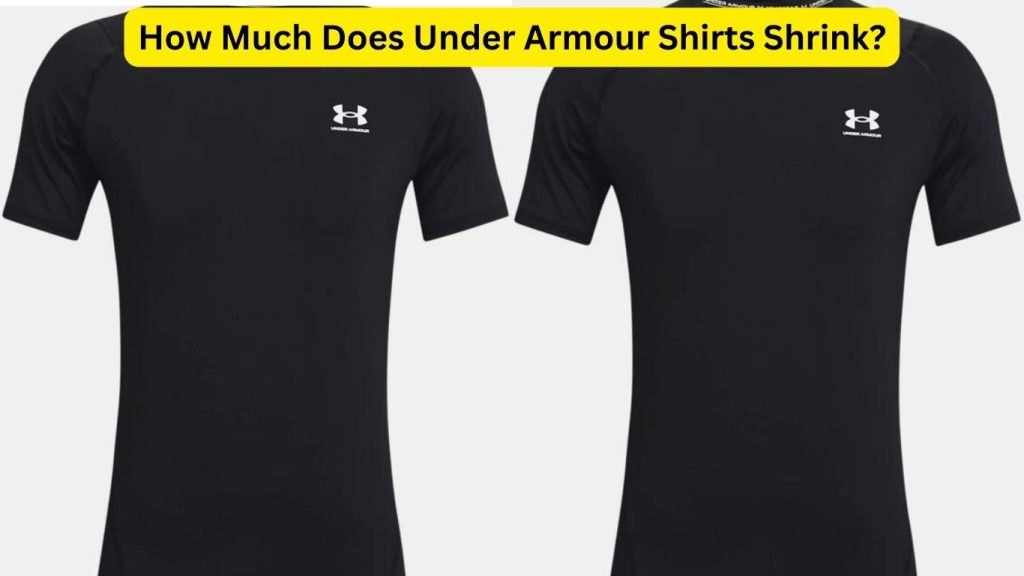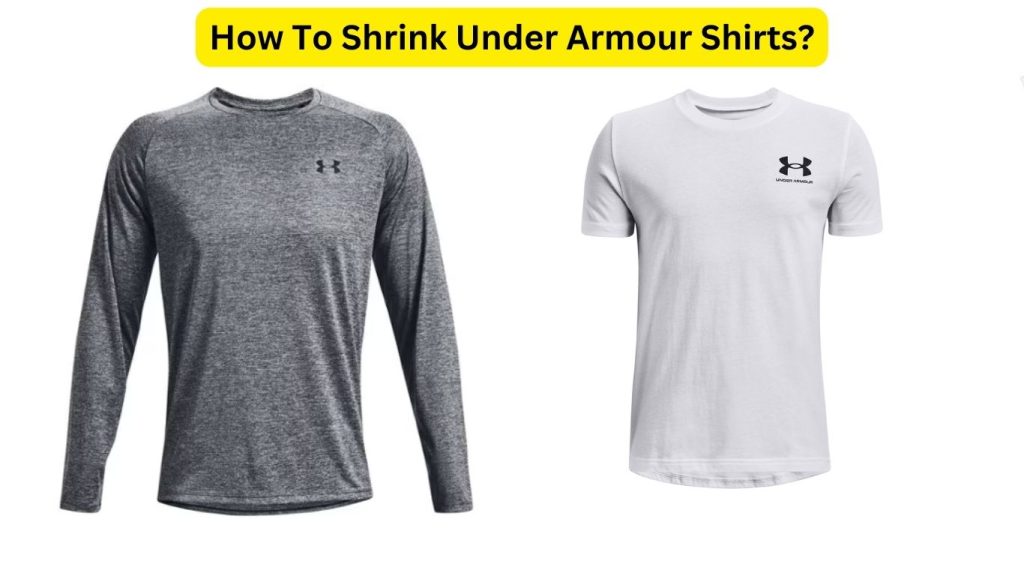Under Armour shirts have become synonymous with high-performance athletic apparel, renowned for their innovative designs and moisture-wicking technology. One common concern among users is whether these shirts are prone to shrinking after washing and wear.

This comprehensive guide delves into the science behind Under Armour fabrics, exploring factors that contribute to shrinkage, and provides practical tips to maintain your shirts’ optimal fit.
From understanding fabric composition to mastering proper care techniques, we’ll empower you with the knowledge needed to make informed decisions about washing and preserving your Under Armour shirts. Stay comfortable, stylish, and shrinkage-savvy with our expert insights.
Table of Contents
- Do Under Armour Shirts Shrink?
- Does Under Armour Shirts Shrink In The Dryer?
- Does Under Armour Shirts Shrink In Wash?
- How Much Does Under Armour Shirts Shrink?
- Can You Shrink Under Armour Shirts?
- How To Shrink Under Armour Shirts?
- How To Unshrink Under Armour Shirts?
- How To Prevent Under Armour Shirts From Shrinking?
- Final Words
Do Under Armour Shirts Shrink?
Yes, Under Armour shirts can experience some degree of shrinkage after washing and drying. The extent of shrinkage largely depends on factors such as the fabric composition, washing method, and heat exposure during drying.
Most Under Armour shirts are made from a blend of synthetic materials like polyester and elastane, which can be more resistant to shrinking compared to natural fibers.
To minimize shrinkage, it’s recommended to wash your shirts in cold water, use a gentle cycle, and avoid high heat settings when drying. Following these precautions can help maintain the optimal fit and performance of your Under Armour shirts.
Does Under Armour Shirts Shrink In The Dryer?
Yes, Under Armour shirts can shrink in the dryer, especially if exposed to high-heat settings. The synthetic blend of materials used in many Under Armour shirts, including polyester and elastane, can be sensitive to heat.

When exposed to excessive heat during the drying process, these materials may contract and cause the shirt to shrink in size.
To prevent or minimize shrinkage, it’s advisable to use a low heat setting or air dry your Under Armour shirts. Following proper care instructions and avoiding high heat can help preserve the fit and quality of your shirts over time.
Does Under Armour Shirts Shrink In Wash?
In general, Under Armour shirts made from synthetic materials like polyester and elastane have a relatively low likelihood of shrinking in the wash.

These materials are engineered to withstand washing and maintain their shape well. However, if washed using excessively hot water and aggressive washing cycles, there’s a possibility of slight shrinkage.
To minimize this risk, it’s recommended to use cold water, a gentle cycle, and avoid high heat during drying.
By following proper care instructions, you can help ensure that your Under Armour shirts retain their fit and performance without significant shrinkage after washing.
How Much Does Under Armour Shirts Shrink?
Under Armour shirts can shrink due to a combination of factors related to their fabric composition and washing methods. Many Under Armour shirts are crafted from synthetic materials such as polyester and elastane.

When subjected to high temperatures, these materials can undergo thermoplastic deformation, causing the fibers to contract and the shirt to shrink. Aggressive washing cycles, coupled with warm or hot water, can exacerbate this process.
The friction and heat generated during washing and drying can disrupt the fibers’ arrangement, leading to a reduction in overall size. To prevent shrinkage, opt for gentle washing, cold water, and controlled drying settings.
Can You Shrink Under Armour Shirts?
Yes, it is possible to shrink Under Armour shirts, although the extent of shrinkage can vary based on factors like fabric composition and care methods. Under Armour shirts are often made from synthetic materials like polyester and elastane, which can contract when exposed to heat and agitation during washing and drying.

If intentionally attempting to shrink a shirt, using higher temperatures during washing and drying might achieve some shrinkage.
However, it’s important to note that shrinking results might be unpredictable, and there’s a risk of damaging the shirt’s quality. Care should be taken, and it’s generally advisable to follow proper care instructions.
How To Shrink Under Armour Shirts?
Shrinking Under Armour shirts is possible, but it should be approached with caution, as there’s a risk of damaging the fabric.

Here’s a general guideline if you wish to attempt shrinking:
- Wash with Hot Water: Wash the shirt in hot water. Hot water can cause the synthetic fibers to contract, leading to shrinkage. However, avoid using boiling water, as it can damage the fabric.
- Dry on High Heat: Place the shirt in the dryer in a high heat setting. The heat will further encourage the fibers to contract.
- Monitor Carefully: Keep a close eye on the shirt during the drying process. Check its size periodically to prevent excessive shrinkage or damage.
- Repeat if Necessary: If the desired level of shrinkage isn’t achieved in the first attempt, you can repeat the process.
Remember, there’s no guaranteed outcome, and the shirt might not shrink evenly. Additionally, aggressive shrinking attempts can weaken the fabric and affect the shirt’s overall quality and longevity. Always follow care instructions and consider the risks before attempting to shrink your Under Armour shirt.
How To Unshrink Under Armour Shirts?
Unshrinking clothes, including Under Armour shirts, can be challenging, but there are a few methods you can try:
- Soak in Lukewarm Water and Conditioner:
- Fill a basin with lukewarm water.
- Add a small amount of hair conditioner or baby shampoo to soften the fibers.
- Gently soak the shrunken shirt in the mixture for about 30 minutes.
- Gently stretch and reshape the fabric while it’s submerged.
- Rinse with cool water and press out excess water (do not wring).
- Lay the shirt flat on a towel and gently stretch it to its original size. Allow it to air dry.
- Stretching and Reshaping:
- Fill a sink or basin with lukewarm water.
- Submerge the shirt in the water and gently stretch and reshape it.
- Remove the shirt and blot it with a towel to remove excess moisture.
- Place the shirt on a flat surface and gently stretch it back to its original shape.
- Allow it to air dry.
- Commercial Unshrinking Products: There are products available that claim to help unshrink clothes. Follow the instructions on the product carefully.
- Professional Help: If the shirt is valuable or particularly challenging to unshrink, consider seeking assistance from a professional tailor or dry cleaner. They might have specialized techniques to restore the garment.
Remember that results may vary, and unshrinking isn’t always guaranteed to work perfectly. Additionally, excessive stretching or manipulation can damage the fabric further, so be gentle in your approach. Preventing shrinkage through proper care is the best approach to maintaining the original size and fit of your Under Armour shirts.
How To Prevent Under Armour Shirts From Shrinking?
Preventing Under Armour shirts from shrinking requires careful attention to their care and washing practices. Here’s how to minimize the risk of shrinkage:
- Read Care Labels: Always follow the care instructions provided on the garment’s label. They offer specific guidance tailored to the fabric’s characteristics.
- Wash in Cold Water: Use cold water for washing. Hot water can cause fibers to contract and increase the likelihood of shrinkage.
- Gentle Cycle: Opt for a gentle or delicate washing cycle. Aggressive cycles can stress the fabric and lead to shrinkage.
- Avoid High Heat: When drying, use a low heat setting or air dry. High heat can cause synthetic fibers to shrink. If using a dryer, remove the shirt while slightly damp to avoid over-drying.
- Limit Agitation: Minimize excessive agitation during washing and drying to prevent damage to the fibers.
- Mesh Bags: Consider washing your Under Armour shirts in mesh laundry bags to reduce friction and protect the fabric.
- Separate Colors: Wash similar colors together to avoid potential dye transfer that could affect the fabric’s integrity.
- Fold, Don’t Hang: Instead of hanging the shirt, fold it neatly to prevent stretching from the weight of the fabric.
- Avoid Sunlight: Store your shirts away from direct sunlight, as prolonged exposure to UV rays can weaken the fibers.
- Use Fabric Softeners Sparingly: Fabric softeners can affect the fabric’s moisture-wicking properties, so use them sparingly or opt for a specialized sports detergent.
- Spot Clean When Possible: If the shirt isn’t heavily soiled, spot cleaning can reduce the need for frequent washing, which can stress the fabric.
- Follow Drying Instructions: If your shirt has specific drying instructions, such as “lay flat to dry,” adhere to them to prevent distortion.
By implementing these preventive measures, you can maintain the fit, quality, and performance of your Under Armour shirts, minimizing the risk of shrinkage and other potential issues.
Read Next:
Final Words
In the realm of athletic apparel, the concern of Under Armour shirts shrinking is one that can be managed effectively with the right knowledge. While some shrinkage is possible due to the nature of fabrics and their composition, proper care can significantly mitigate this issue.
By following the guidelines presented in this guide, including using cold water, gentle washing cycles, and avoiding excessive heat during drying, you can preserve the fit and performance of your Under Armour shirts.
Remember, understanding the materials and employing smart laundry practices will ensure your shirts not only stay comfortable but also retain their high-performance qualities over time.
